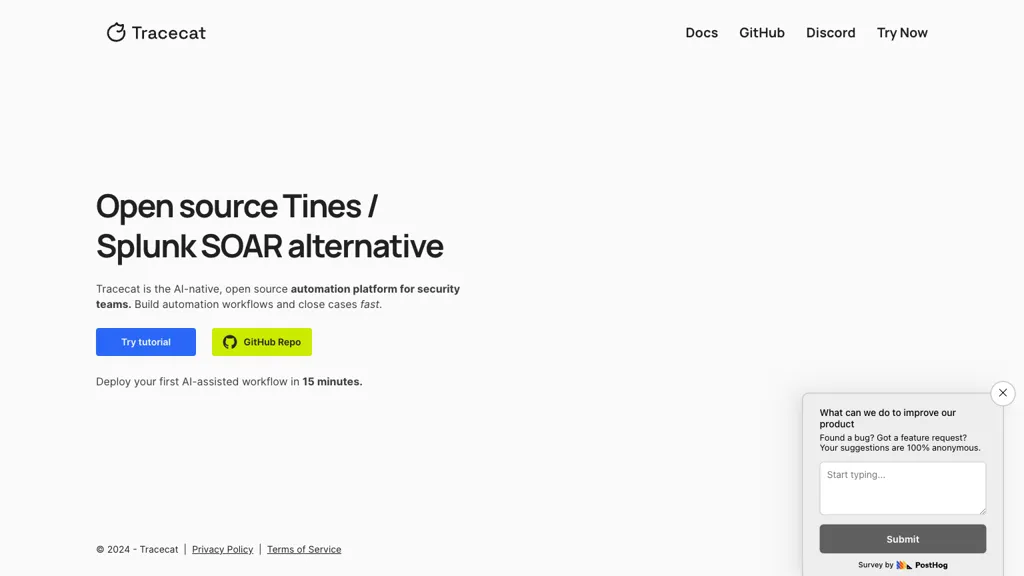What is Tracecat?
Tracecat is an open-source automation platform for security teams. It occupies a rare position, being AI-native and an alternative to leading platforms like Tines or Splunk Soar. One can simplify his security operations in Tracecat by developing effective automation workflows that accelerate case closure. Extensive tutorials are included in its GitHub repository, and the first AI-enabled workflow can be deployed in 15 minutes.
Key Features & Benefits of Tracecat
The key features of Tracecat include the following: it is an automation platform built for security teams; a substitute for Tines and Splunk Soar, it offers advantages in its functionalities. One can create workflows to be automated to make life easier in security operations. GitHub tutorials are available for detailed guides and tutorials on quickly deploying AI-assisted workflows.
Light Speed Deployment: Be deployment-ready with your first workflow in just 15 minutes, guided through easy tutorials.
With these functionalities, Tracecat provides a lot of value by reducing manual workload on security incident handling, shortening the mean time to resolve an incident, and enhancing the efficiency and team collaboration for security teams.
Use Cases and Applications of Tracecat
Tracecat is designed to be versatile and handle several scenarios:
-
Automate Threat Response:
Leverage Tracecat’s AI-native platform for running automated threat response processes and drive down the huge amount of manual effort involved in managing security incidents; accelerate incident resolution. -
Improve Team Collaboration:
Using Tracecat, create seamless automation workflows to drive real-time information sharing and consistent responses to potential threats in order to enhance collaboration among security teams. -
Improve Security Posture:
Trigger tailored automation workflows with Tracecat for repeatable, dependable security operations to ensure the efficiency and effectiveness of your security teams.
In general, Tracecat will become very key in helping a security team manage its operations and build better capabilities towards rapid, effective responses against adversaries.
Using Tracecat
Getting started with Tracecat is easy:
-
GitHub Repository:
You can view Tracecat’s GitHub repository for tutorials and documentation. -
Follow Tutorials:
The web-based, step-by-step tutorials will get your first AI-powered workflow up and running in less than 15 minutes. Once you have experienced just how powerful Tracecat is, feel free to create your automation workflow using Tracecat’s intuitive interface. -
Monitor and Optimise:
Your workflows should be continuously monitored, and changes should be made to further enhance performance.
Best practices include updating the workflows regularly, having the whole security team involved, and making use of advanced features through tutorials provided by Tracecat.
How Tracecat Works
Advanced AI algorithms and models at Tracecat apply to automating workflows in security. The platform is integrated with existing security tools and systems for seamless data flow and real-time analytics. A broad overview of its workflow would look somewhat like this:
-
Data Integration:
Tracecat integrates with a number of data sources for security information. -
AI-Driven Analysis:
AI algorithms analyze the data and spot potential threats. -
Automation Workflows:
Automates the response process by creating and then running predefined workflows. -
Continuous Monitoring:
Providing constant monitoring and feedback for effective security operations.
Tracecat Pros and Cons
Like any other tool, Tracecat does have pros but also some possible cons:
-
Pros:
- Enhances efficiency through the automation of regular security tasks.
- Quick deployment is facilitated through detailed tutorials.
- Facilitates better collaboration among security teams.
- The workflows are customizable to suit specific security operations.
-
Cons:
- Being an open-source tool, it may be a little tricky to operate at optimum capacity.
- Fewer feature sets compared to a few paid services.
User reviews range from mostly praise of the overall performing tool and ease of use. From time to time, one does come across comments related to a steep learning curve when going further with mastery of advanced features on the platform.
Price of Tracecat
One of the key benefits of Tracecat is that this solution is open-sourced and therefore free to use. Added to this is its great capability, making it also very cost-effective compared to commercial products like Tines and Splunk Soar. Access to this tool is openly provided directly from its GitHub repository, and there are no additional costs for end users to access it.
Conclusion about Tracecat
Wrapping up, Tracecat is indeed a full-featured, open-source automation platform that has given great reasons to rethink the arsenal of security teams worldwide. Its AI-native feature set, friendly tutorials, and rapid on-premise deployment make it an interesting option for those looking at alternatives like Tines and Splunk Soar. With some technical know-how, it will buy considerable efficiency, collaboration, and cost-effectiveness for Tracecat. The platform is bound to evolve in bringing in even more advanced capabilities at each turn, adding value.
Tracecat FAQs
-
What is Tracecat?
Tracecat is an open-source automation platform that empowers security teams and streamlines security operations with AI-powered workflows. -
How do I get started using Tracecat?
See the Tracecat GitHub repository for a first look at Tracecat. Using its step-by-step guides, you’ll be deploying your first workflow in 15 minutes. -
What are some of the main benefits of using Tracecat?
Free because open source, Tracecat will come with better efficiency, teamwork, and customized workflows. -
Does Tracecat have any disadvantages to using it?
While Tracecat is indeed effective, advanced functionality and use may be difficult unless the user has a technical background; meanwhile, support will be quite limited compared with commercial solutions.










